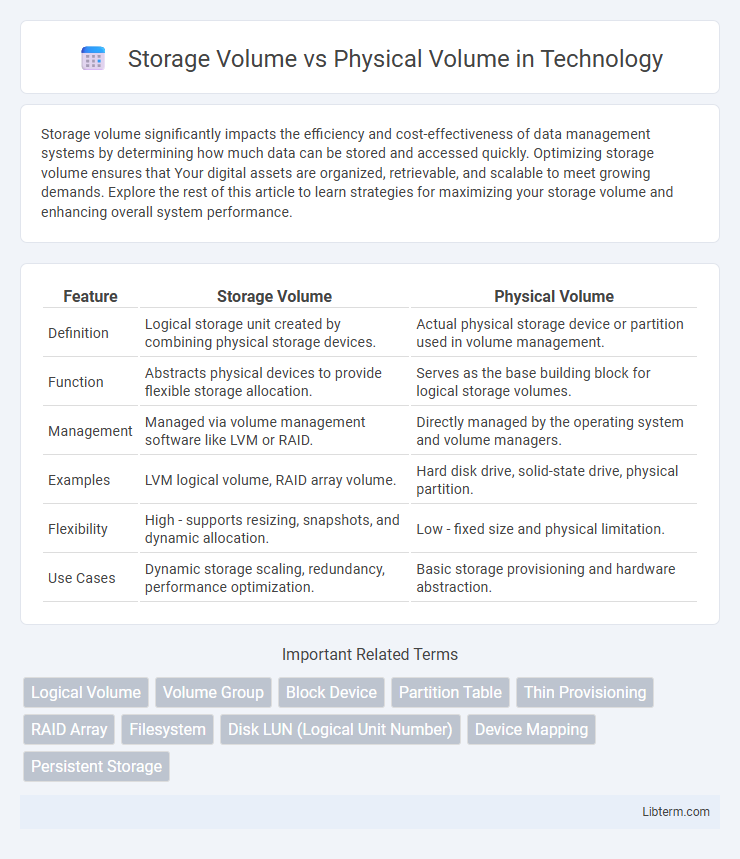Storage volume significantly impacts the efficiency and cost-effectiveness of data management systems by determining how much data can be stored and accessed quickly. Optimizing storage volume ensures that Your digital assets are organized, retrievable, and scalable to meet growing demands. Explore the rest of this article to learn strategies for maximizing your storage volume and enhancing overall system performance.
Table of Comparison
| Feature | Storage Volume | Physical Volume |
|---|---|---|
| Definition | Logical storage unit created by combining physical storage devices. | Actual physical storage device or partition used in volume management. |
| Function | Abstracts physical devices to provide flexible storage allocation. | Serves as the base building block for logical storage volumes. |
| Management | Managed via volume management software like LVM or RAID. | Directly managed by the operating system and volume managers. |
| Examples | LVM logical volume, RAID array volume. | Hard disk drive, solid-state drive, physical partition. |
| Flexibility | High - supports resizing, snapshots, and dynamic allocation. | Low - fixed size and physical limitation. |
| Use Cases | Dynamic storage scaling, redundancy, performance optimization. | Basic storage provisioning and hardware abstraction. |
Introduction to Storage Volume and Physical Volume
Storage volumes represent logical storage units that abstract and aggregate physical storage resources for flexible data management and allocation in computing environments. Physical volumes refer to actual hardware storage devices or partitions, such as hard drives or SSDs, that provide the foundational capacity for creating storage volumes. Understanding the distinction between physical volumes as tangible storage media and storage volumes as virtualized storage containers is crucial for optimizing storage infrastructure and performance.
Defining Storage Volume
A storage volume refers to a logical unit of storage that an operating system uses to organize and manage data, often spanning multiple physical disks to create a single accessible space. It abstracts physical volumes, which are the actual hardware devices or disk partitions, enabling flexible storage allocation and easier data management. Storage volumes facilitate features like RAID configurations, snapshots, and dynamic resizing, enhancing storage efficiency and reliability.
Understanding Physical Volume
A Physical Volume (PV) is the fundamental storage component in Logical Volume Management (LVM) that represents a physical hard disk, partition, or storage device prepared for volume management. It serves as the raw storage resource that can be divided and allocated to create Storage Volumes or Logical Volumes, enabling flexible and efficient space usage. Understanding Physical Volume management is critical for tasks like disk initialization, resizing, and managing storage capacity in Linux systems.
Key Differences Between Storage Volume and Physical Volume
Storage volume refers to a logical unit of storage created from one or more physical volumes, allowing flexible allocation and management of disk space, while a physical volume is the actual physical hard drive or partition in the storage system. Storage volumes provide abstraction and can span multiple physical volumes to enhance performance and redundancy, whereas physical volumes represent the real hardware components where data is ultimately stored. Key differences include storage volumes being virtual constructs enabling features like resizing and snapshots, in contrast to physical volumes which are limited by physical disk capacity and structure.
How Storage Volumes Work in Modern Systems
Storage volumes in modern systems abstract physical storage into manageable units, enabling flexible allocation of space across multiple devices. They function as logical containers that the operating system treats as single drives, often leveraging technologies like Logical Volume Management (LVM) or software-defined storage to optimize performance and redundancy. Physical volumes represent the actual hardware components such as hard drives or SSDs, while storage volumes aggregate these resources, allowing dynamic resizing, snapshot creation, and simplified data management.
Role of Physical Volumes in Storage Infrastructure
Physical volumes serve as the foundational hardware components in storage infrastructure, representing the actual physical storage devices such as hard drives or SSDs. They provide the raw storage capacity that is aggregated and abstracted into storage volumes, enabling flexible data management and allocation. This abstraction allows storage volumes to be resized, mirrored, or striped without directly affecting the underlying physical hardware, enhancing scalability and redundancy in enterprise storage systems.
Advantages of Using Storage Volumes
Storage volumes offer enhanced flexibility by allowing dynamic resizing and easier management compared to physical volumes tied directly to hardware. They enable efficient utilization of underlying storage resources through features like snapshots, replication, and thin provisioning. Storage volumes also improve data protection and recovery options, supporting advanced backup and cloning mechanisms not typically available with physical volumes.
Limitations and Considerations of Physical Volumes
Physical volumes in storage systems have limitations related to fixed size and hardware dependency, restricting flexibility when scaling storage capacity. They require careful consideration of device compatibility, partition alignment, and performance impact due to physical disk characteristics. Management of physical volumes also involves challenges in fault tolerance and recovery compared to logical storage volumes, which offer better abstraction and scalability.
Use Cases: When to Choose Storage Volume vs Physical Volume
Storage volumes are ideal for scenarios requiring flexible, scalable, and easily managed storage units, such as virtualized environments or cloud-based applications, where dynamic allocation and resizing are essential. Physical volumes are preferred in use cases demanding dedicated, high-performance storage with direct hardware access, such as database servers or high-throughput transactional systems. Choosing between storage volume and physical volume depends on the need for abstraction and scalability versus raw speed and hardware-level control.
Conclusion: Making the Right Storage Choice
Selecting between Storage Volume and Physical Volume depends on specific storage needs and system architecture. Storage Volumes offer flexibility and easier management through logical abstraction, while Physical Volumes provide raw hardware capacity and direct control. Prioritizing scalability, performance requirements, and administrative convenience ensures the right storage choice for optimal data management solutions.
Storage Volume Infographic

 libterm.com
libterm.com